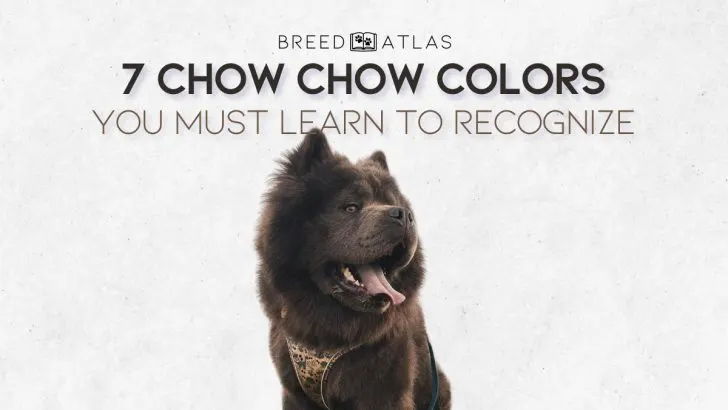The Chow Chow is a legendary dog breed that many people around the world grew fond of. Their easily recognizable appearance, together with the rarity of having this dog breed, makes people stop and look whenever they see these magnificent Chow Chow colors.
Aside from the Chow Chow colors, their personalities are what makes them interesting, too. Known for their stubborn, aloof, and independent personalities, these dogs don’t fit into just any type of family.
If you have what it takes, this dog breed can be a great addition to you and/or your family. But, the things that we are primarily interested in this article are the colors that this dog breed can come in.
To get to colors, we must look over the history of this dog breed and the general physical characteristics in order to get to and understand the Chow Chow colors.
In case you are looking to buy this dog breed, or if you are just curious about them, you are probably interested in the coat colors it can come in. Some people like dogs that are of lighter colors, and others like dogs that are of darker colors.
And the Chow Chows have it all!
General Appearance And Physical Traits Of The Chow Chow Dogs
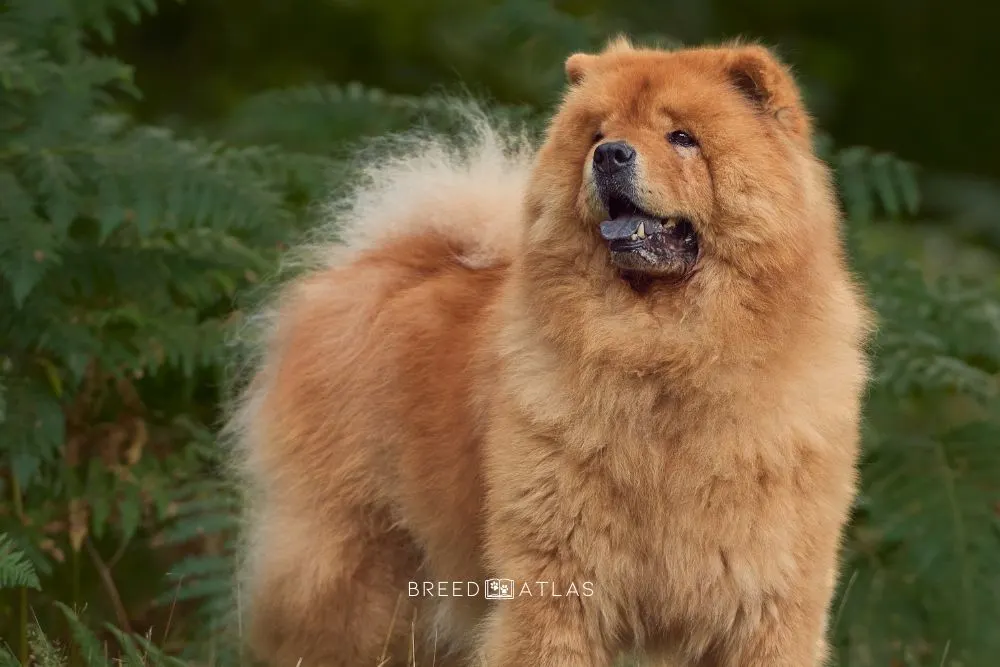
This fashionable pet is famous for its good looks. Elegant, unique, and fluffy, it draws attention and steals the spotlight wherever it goes.
The unique look this dog possesses makes him interesting to all family members. Large to medium average size, this dog breed usually weighs between 50 and 80 lbs and is from 17 to 20 inches tall.
They generally have recognizable “lion’s mane” ruff around the front part of their body, the head, neck, and shoulders, which probably developed naturally to protect their vitals, as they were bred for herding, guarding, and similar jobs.
They have a distinct dark blue or black tongue, which is known only for Chow Chows and Shar Peis. It is a physical characteristic of this dog breed that we will delve into later.
They have almond-shaped eyes that are deep-set into the head, and you often cannot see the shape of their eyes well because of their thick coat that can often go around their eyes, forming a stilted gait.
Their body is somewhat square, adding up to their large heads and really cute, triangular ears. Even if it happens that you see a shaved dog of this breed, you will see that their bodies are bulky and powerful.
They do have a thick fur that is double-coated. They don’t really thrive in hot areas and might become nervous because of that. If you decide to have a Chow Chow in a warm or hot area, make sure that your dog is provided with AC.
Their fur is soft and easily gets tangled. They have a curled tail that stands curled on top of their backs.
Chow Chow Colors
Understanding Chow Chow colors can be confusing if you haven’t seen them already in person, or if you haven’t read about them or seen a picture yet.
Why am I saying this, since this is so logical? Well, some coat colors have names that don’t really connect to the visual representation.
When I say blue Chow Chow color, you will probably imagine some kind of dark blue, right? But it is not. To better describe the coat colors, and for you to understand them perfectly, aside from description, you will be able to see them visually in the following paragraphs.
1. Red

Red Chow Chows have various shades of red. So we can put it somewhat like this – Chow Chows with a reddish coat color, ranging from light golden to deep mahogany, are referred to as red Chow Chows.
A dog’s white undertones on its tail, nose, breechings, and ruff indicate that it is a desirable example from reputable Chow Chow breeders. These dogs will be recognized by their reddish-hued appearance.
If you are living in the UK, and looking for Chow Chow breeders, make sure to check out the 5 Best Chow Chow Breeders In The UK You Can Trust!
These white undertones are optional, though. A completely red Chow Chow may still compete in confirmation shows. Additionally, the eyes and nose of Red Chow Chows will always be dark brown to black.
Most of them will have entirely black gums. The tongue is always dark blue, the nose usually black, the eyes – dark brown, the lips black, and the palate dark.
A red puppy coat typically has a faded shade. The puppy may have a black tail tip and a dark muzzle, but that fades away.
2. Cream

The cream color is my favorite one when it comes to Chow Chows. When they are cream-colored, they usually also have biscuit-colored ears and black noses.
Their tongue pigmentation and plate are dark blue, their lips are black, eyes are usually dark brown. Their gums are pink. The shades of the cream Chow Chow can go from almost white to a very light red.
This color can vary from champagne to a gorgeous yellow shade, which is the most desired spectrum of this color.
When born, puppies of this shade should have a black nose that goes pinker as they get older. By the time they reach 18 months of age or fully grow – their noses should be pinkish.
If the cream Chow Chow remains having a dark nose, it won’t be able to attend dog shows, because having a dark nose in this color is not up to breed standards.
Their eyes are desirably dark brown, but can sometimes be dark amber.
3. Black
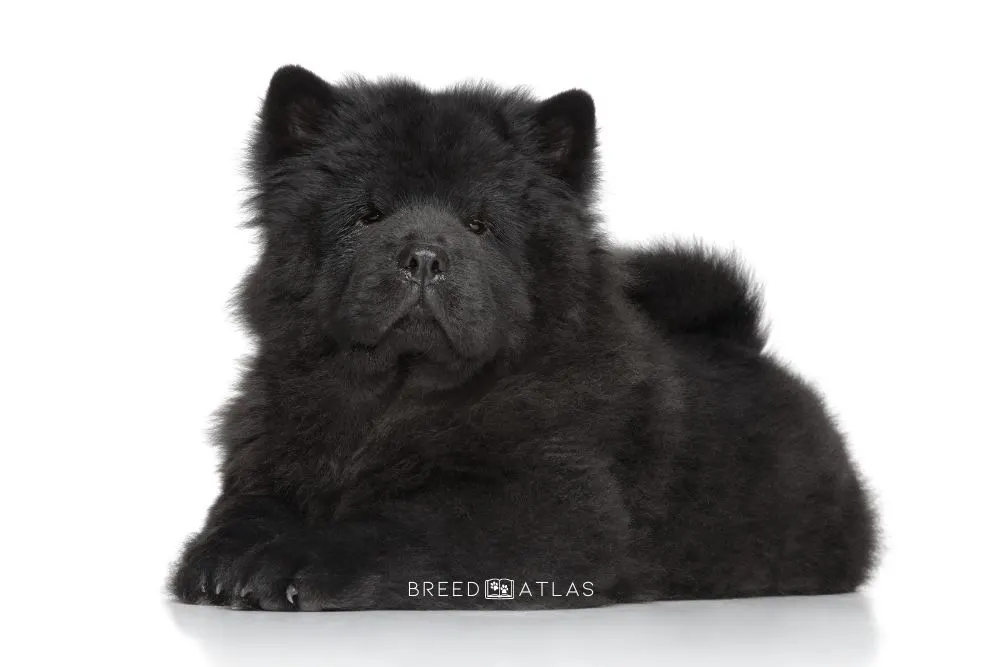
This is quite different from the usual red or cream-colored Chow Chow.
Should you come across black Chow Chow puppies, you will see that their coats are quite dark without any shine to them, almost looking matte. This is because the dog’s coat type will change as it ages. The shine comes with maturing!
Their coats may become a little grayish as they mature, but they will still have the shine that makes these dogs look so well put together.
Conforming to the breed standard, black Chow Chows also have dark brown eyes and a black nose.
4. Dark Brown

This color of the Chow Chow is not up to the breed’s standards. But it is the most beautiful one if you ask me.
This unique color has a royal appearance. Just like pure brown kittens without any marks or undertones are rare, so is the Chow Chow in this color.
These loyal companions in brown are a prized asset since you won’t just see them walking anywhere randomly on the street.
Being rare, and not ‘unhealthy’ rare as the albino ones, I like to see them as really special and beautiful ones.
5. White
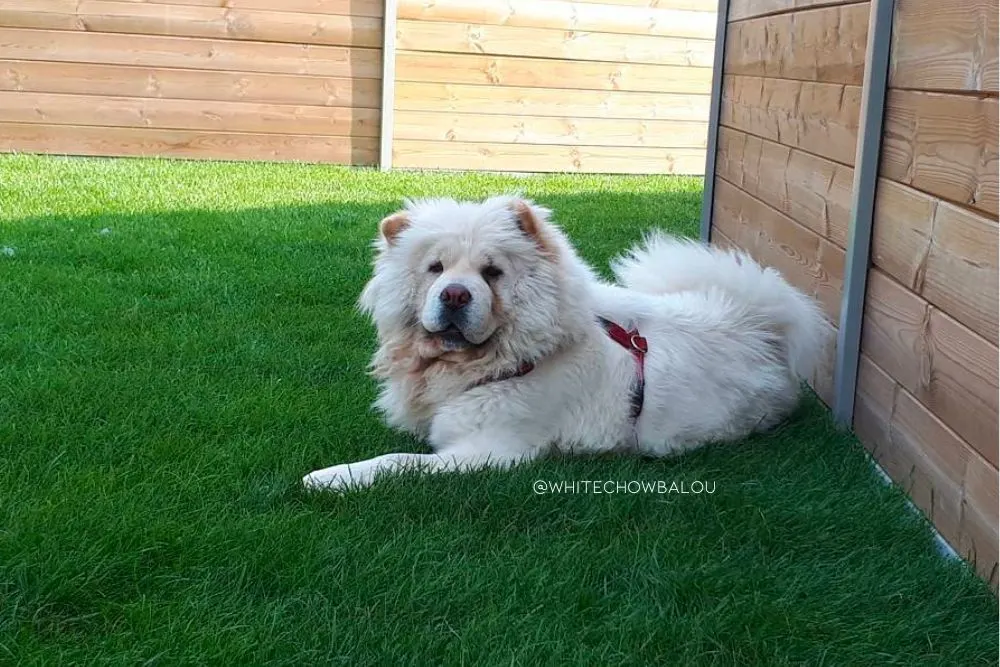
When it comes to Chow Chows, white is a color that many breeders and fans discuss. This is due to the fact that albinism or the double merle gene are typically the causes of this beautiful Chow Chow color.
White Chow Chows have a pure white coat, as their name would imply. However, Albino Chow Chows will also have a bright pink nose and vivid blue or red eyes, and pure white ones will have dark eyes and a dark nose.
Double merle Chow Chows may have a butterfly nose, as well as an occasional color patch. Though heterochromia is not rare, their eyes will typically be blue.
The issue with white coats is that it’s linked to a lot of diseases, particularly when albinism is the reason. These dog’s skin will likely have extreme sensitivity, in addition to other health problems, such as blindness or hearing issues.
Still, it appears that white Chow Chows are in high demand. They genuinely distinguish themselves from other Chow Chows with their elegant look, making them similar to Samoyeds.
Cream Chow Chows and white Chow Chows are frequently mistaken. Examining the finer points will reveal whether your dog is cream or white. They are not agreed upon as one of the representative colors, because of the possible health issues that can go with it.
6. Blue

This is one of the colors that I was talking about a few paragraphs above – the blue Chow Chow is not actually blue, it is more of a deep dark gray.
A dilution gene that affects black coats causes blue. Steel gray shading is the most sought-after shade of this color, but any silver-ish shade is suitable.
Blue Chow Chows can have the “salt and pepper” look due to differences in tint between their muzzle and legs.
This one, as the majority of Chow Chow’s brown eyes, will always have a dark gray or blue nose. This is so because the dilution gene affects the dog’s body color of any black, not simply the color of its coat.
7. Fawn / Cinnamon
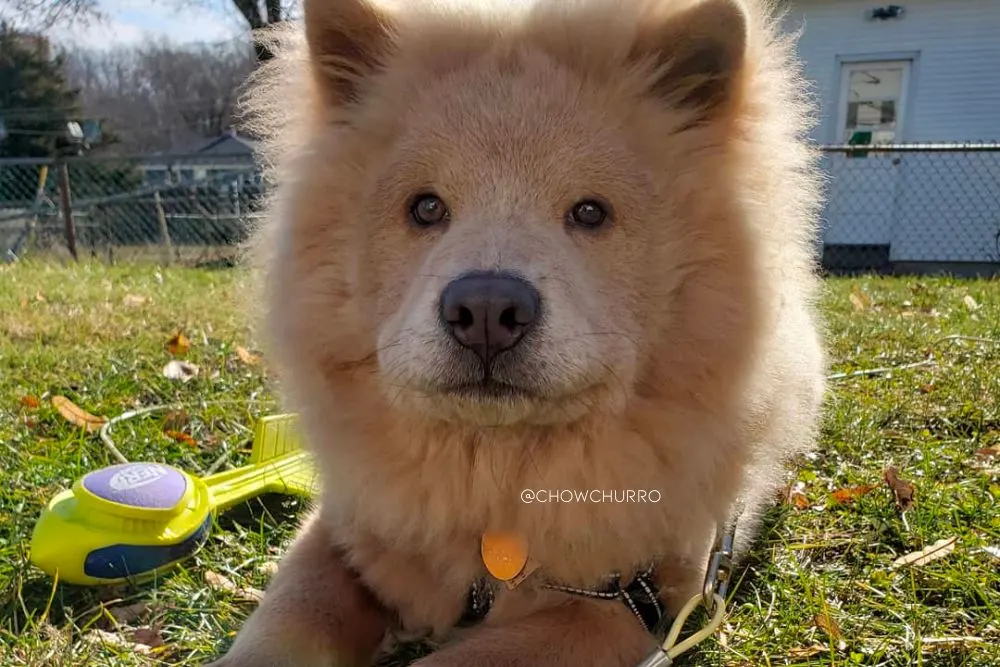
Fawn is an unusual color that Chow Chows occasionally possess. Fawn Chow Chows are red chow chows plus dilution genes.
These puppies have a more golden overcoat over a rather pale or blue undercoat. Many breeders may try to pass off their puppies as being blue fawns if their undercoat has a noticeable blue shade, although this is the same shade.
Because of their striking color similarities, cream canines and fawn Chow Chows can be easily confused. They will, however, always have a liver-colored nose and a bluish tint that normal cream Chow Chows do not have.
Fawn Chow Chows are not accepted by the American Kennel Club (AKC).
Types Of Chow Chow’s Coat
There are two types of hair in Chow Chow’s coat. Those are: rough and smooth.
The dominant gene, referred to as the “wild” gene, is smooth. This means that for smooth puppies to be produced, one of their parents must have a smooth coat, according to the breeders. (Exceptions are extremely uncommon).
If a smooth Chow contains the rough gene, it can produce both smooth and rough offspring. Being a recessive gene, rough must be inherited from both Chow parents.
Chow Chow Colors: Let’s Talk Tongues

With the exception of the Chinese Shar-Pei, the Chow is unique in the canine world due to its blue tongue.
Similar to the Chow Chow, the Shar-Pei’s breed standard is that the mouth and tongue must be bluish-black in hue, with the exception of dilute colours, which may have lavender coloring.
The term “dilute” mostly relates to the pigmentation of the snout, not the coat color, according to the Chinese Shar-Pei coat color DNA study. Any color other than black is regarded as weak.
The resemblance between Chinese Shar-Pei and Chow Chows is likely due to their shared ancestors. They also have blue-black tongues in common with certain types of cattle, giraffes, and polar bears.
The tongues of Chow Chows are not blue from birth. Just like other breeds, Chow Chow pups have pink tongues. Around the period their eyes open, the color of their tongues turns blue-black.
Chow Chows without blue tongues are if you didn’t know, not. allowed to participate in dog shows!
Legends Surrounding The Story Of Chow Chow’s Tongue
There actually are two legends, telling a story of how the Chow Chows’ tongues turned blue.
As you know, Chows were well-liked as pets in ancient China, where they were renowned for their loyalty and devotion as protectors.
They were especially well-liked by the Buddhists, which gave rise to two myths about the origin of their unique tongue.
The monk in the two stories is described as having a Chow Chow as a companion. In the first, the monk had left their brush on the ground while painting the sky. Their dog chewed on the brush and painted their mouth dark blue for the rest of the species.
The second legend is a tale of companionship. A sick monk was unable to gather wood in time for a cold Asian winter.
When their obedient Chow Chow went in search of firewood, all he found were scorched logs. The dog’s mouth became darker as it carried back each piece of wood, eventually turning its tongue and mouth a permanent blue-black color.
The History Of The Chow Chow Dogs
The roots of their ancestry grow deep, and the American Kennel Club (AKC) recognized that by officially setting the breed’s standards in 1903. According to the AKC breed popularity ranking, the Chow Chow takes the 92nd place.
And you know what? Their distinct colors and looks are definitely connected to their history.
Did you know that the indigenous dogs that are from China and East Asia – Akita, Shiba Inu, Chow Chow – were identified as the closest lineages to the gray wolves?
Therefore, these dog breeds are the ones we have today that date from the earliest history.
The Cow Chow is seen in sculptures and pottery of the Han dynasty that ruled from 206 AC to 22 AC. However, there are other sources that connect the Chow Chow’s origins with the Arctic Circle, migrating to China, Mongolia, and Siberia.
Since they were able to perfect a pale blue colour, the monasteries of Tibet became experts in the raising of blue-coated chows, a task that required many generations and a great deal of effort. The Chow Chow is still used for hunting and herding as well as security in monasteries.
Back then, people used the Chow for hunting, herding, guarding, pulling sleighs, and making some clothes out of their coats. In the 1700s, the Chow Chow traveled to America through England. They were delivered in the compartments of the merchant vessels by the sailors.
In Europe, Marco Polo first made reference to the Chow Chow during his travels in China in the thirteenth century. But it wasn’t until merchants and sailors brought Chow back on ships in the late 15th century that they gained popularity in Europe.
In his book, Gilbert White described how a young employee of the East India Company brought two Chow puppies from Canton.
Does Coat Color Affect Chow Chow’s Health?
There are a few health problems that can possibly arise for the Chow Chows, and some depend on the color of their coats. Therefore, it is important to know them, in order to check certain things at the vet.
Some of the most common health issues that Chow Chows face are: hip dysplasia, elbow dysplasia, and patellar luxation, deafness, blindness.
A hereditary disorder in dogs called hip dysplasia causes a propensity for hip laxity to develop early in life. Within the very first few weeks of life, the soft tissues (joint capsule and ligaments) that ordinarily support the hip joint become loose.
As the growth plates in joints are still closing, a diagnosis of elbow dysplasia cannot be made before the puppy is 4 to 6 months old. The majority of dogs require many months to reach a definitive diagnosis. Therapy is guided by surgery and a CT scan to examine the joint.
Dogs frequently experience patellar luxation as an orthopedic issue. Usually found in small-breed dogs, medial luxation is far more prevalent than lateral luxation.
Clinical proof of patellar instability serves as the basis for diagnosis; nevertheless, diagnostic imaging is necessary to determine the degree of bone deformity and the best course of action.
Deafness and blindness are connected to having an albino Chow Chow. The genetics of that dog simply lead to having these hereditary health issues.
They have moderate exercise needs, and there is no special exercise needed. This breed’s level of energy is medium, but you should definitely be careful since they are prone to weight gain. They love food and are often food-motivated.
This independent breed does not have any different needs than other breeds. Regular vet checks, health screenings, exercise, and quality food will do the trick.
Which Of These Chow Chow Colors Looks The Best To You?
After reading all of this useful information about Chow Chow colors, and the breed in general, now it is your time to pick and choose the one you find the most wonderful.
Provided with early socialization and responsible breeding, adding this dog breed to your household can bring you a best friend with whom you would spend many wonderful moments.
People who already own them say Chows are really clean dogs, almost like cats. They will often lick their paws and parts that they can reach, in order to clean themselves.
When it comes to raising one, the best tools you can use are love, positive reinforcement, and AC, because they despise high heat.
Whichever Chow Chow color you decide upon having or being your favorite, I am sure that you have made the right decision, since every single one is beautiful in its own way!
Read next: 9 Reasons Why My Chow Chow Follows Me Everywhere

Zerina is an experienced content writer who found her passion for writing while pursuing her degree in English language and literature.
Growing up with a beloved dog as her companion, Zerina developed love for canines from a young age. Inspired by her bond with her furry friend, she decided to combine her writing skills with her love for dogs.
